|
| Photo
by Justin Parson, courtesy of AMS Production Group |
I
have always loved railroads, both the trains and tracks. I remember
when I visited my grandparents during summers when I was just a boy.
They lived in a small East
Texas town that really doesn't even exist anymore. But the Kansas
City Southern Railroad came through there on its east-west line. Going
east the train had to climb a long two-mile hill. It started blowing
its whistle long before it arrived in town. My grandfather would always
be out on his front porch waiting to see the train. I don't think
he could see that well at this point in his life, and the tracks were
actually about a quarter mile from his house. But he could definitely
hear the whistle. This was what was important to him. I'm sure the
train was just a blur, but the whistle let him know that a long train
was moving through the little hamlet. I always wondered if he had
any longings to wander left over from his early days. He would always
talk to me a little wistfully as he pointed out certain cars on the
train. From that point on I was hooked. One railroad line in particular
has been for me an umbilical cord that has connected me to my roots
and my life. I have lived close to this line for most of my life.
It always reminds me of where I've been and where I could have gone.
I grew up in a city in Louisiana. Our home was so close to the Southern
Pacific Railroad (SP) that every time a train passed by, the house
would shake just as though we were in an earthquake. Cracks would
develop in the ceiling, windows would rattle, and I was convinced
that the earth moved. When I was little the line still had steam engines,
and fortunately for me there was a passing track right behind the
house. Only our backyard and a highway stood between those trains
and me. Whenever a train pulled over on the siding to let another
one pass, I could examine the engine up close. Sometimes the engineer
would talk to me. The line was a busy one, so all day long I was seeing
trains, or at least hearing them. At night the mournful whistles woke
me up. I didn't mind. I loved the sound.
The SP was the only railroad I was familiar with in my younger days.
I got older and my parents trusted me to explore the territory surrounding
us. This is when I discovered the line that has meant so much to me.
This railroad started out as the Texas & Pacific (T&P). Over the years
the original T & P became the Missouri Pacific (MP) and now the Union
Pacific (UP). But the name is not so important as my connection to
the line.
The T & P had a rail yard within a couple of miles of my home. It
was very near the junior high school I attended. In fact, all day
long I could hear whistles blow and the sounds of switching as I sat
in my classrooms. After school, instead of going home, I headed for
the yards. There were several workshops on the edge of the yards.
Most of these had long been abandoned, but they were not stripped
of their insides. I found all kinds of rusty machinery, tools for
various usages, wheels, and even a detached smokestack from a steam
engine. Something I didn't want to find - rats - were all over the
place. My special treasure was an old passenger car. All the seats
were still in place and covered with so much dust that one could have
planted a garden within. But I would sit in the car, look at the switch
engines outside and imagine myself on a journey. My life's journey
has never been far removed from the T & P line. It has kept me attached
to a particular area of the world and to the many characters - a gaggle
of goofballs, really - I have met along its route. It offered both
hope for the places I could go and disappointment over missed opportunities
to travel in other directions.
The T&P was laid out in a, to me, rather unusual way. It has probably
been altered by now, but when I was a boy the basic east-west tracks
approached the city from the south and the main lines curved back
off to the southeast just before the rail yard began. A second line
for passenger service spurred off before the main line curve, went
through the switching yard, and terminated at a very stylish station
on the north end of downtown. Freight service on this spur was fairly
light, and passenger service was dwindling. |
I once had a
summer job for an auto parts firm whose location was near the old
T & P station. During the lunch hour I would explore the area around
the station. To my delight I discovered a second main line that ran
north through an alligator-infested swamp not far from downtown. The
line once ran up into Arkansas, but most of it had sadly been abandoned
by the time I came upon it; some small village in North Louisiana
was the new terminus. The T & P obviously used the line for storage
of boxcars, tankers, and hoppers. There must have been thousands of
them for me to mount and walk end to end on their tops. I was still
too young to know that the exploits with the railroad were prescient
in a way. I feel now that I've been on a train that has led nowhere.
No engine was there to pull it. But then all I knew was that I had
a fascination for these great mechanical beasts of burden that was
growing exponentially.
My desire for exploration was satisfied by another partially abandoned
branch of the T & P. This one forked off the main line south of the
city, about five miles before the great southeast curve. It once traveled
about seventy miles to a town in West Louisiana, but by the time I
was a teenager, the line ran only for a tenth of this distance from
its junction with the main line through a heavily wooded area. It
was used exclusively for storage. Again, I spent many hours walking
the tops of boxcars, pretending an engine was up front and that I
was a hobo riding the rails.
Eventually, the T & P station downtown closed and a new station was
built in the south part of town, just before the great curve. It was
little more than a glorified house trailer fixed up to look like a
train station. By this time the T & P had become the Missouri Pacific,
whose engines were bright blue and cabooses the traditional red. Passenger
service was almost at an end. When I was in college I managed to have
one more adventure on a MP passenger train.
I had a college friend who lived about 125 miles from my home. He
invited me to his house over the Christmas holidays, but I had no
way to get there except by bus or train. His hometown was on the MP
route, so naturally I chose the train. I went to the new station to
catch it and was amazed to see the sad state of passenger service
on the line. There my conveyance sat: a big blue engine and one rather
dilapidated coach - one coach! I knew the end of an era was in sight,
but I climbed aboard for what turned out to be my last ride on an
MP passenger train. The line paralleled both a state highway and the
Red River, and part of its route was through some swampy, marshy land.
The coach was almost deserted; the countryside appeared this way also.
Each served as a symbol for the other. Emptiness is neither a pretty
sight nor a pleasant feeling, and the trip made me sad to think that
a way of life that I grew up with was disappearing. The hands of Providence
removed me from the T & P / MP line after this trip, but I was destined
to come back to it someday. |
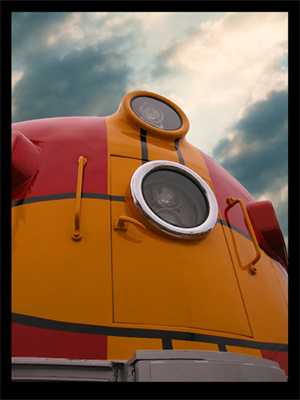 |
| Photo
by Justin Parson, courtesy of AMS Production Group |
II
After
my graduation from high school, I chose to attend a college about
seventy-five miles to the east. The MP had no lines extending in this
direction, but I was pleasantly surprised to find that in my new college
town the Illinois Central (IC), an east-west line, crossed the Rock
Island (CRI&P), a north-south line, at a beautiful old train station
on the edge of downtown. The IC was still running passenger service
at this time, so it occupied the old station's waiting room and ticket
office. The Rock Island was strictly a freight line, which had an
interchange track with the IC. I spent time in which I probably should
have been studying to watch the IC stop to exchange cars with the
Rock Island. I was fascinated to watch the switch engines do their
work.
The IC ran right beside my first dorm room. It was easier to get downtown
to the movie theaters by just walking the tracks rather than city
streets. The railbed was in a deep gully, though, and the darkness
prompted me to walk faster. Once, on my way back to the dorm after
a midnight movie, a dog ran out of the ivy that covered the sides
of the gully and started toward me. This was bad enough, but when
I heard a voice say, "He won't hurt you," I almost lost it. Somebody
else was out on a late night trek in my domain. For a few weeks after
this I avoided the gully and took an alternate route to the theaters.
Two
events connected with the IC bring back both sad and funny memories.
Once a young deaf girl was walking the tracks to the downtown area
as a train approached her from the rear. The engineer obviously spotted
her and started blowing his whistle, but the poor girl couldn't hear
it. The engineer applied his brakes, but the train had built up too
much momentum to stop in time, and the girl was crushed beneath the
wheels. The whole town, including me, mourned for a long time. It
seemed such a senseless tragedy. The second event was humorous. There
was an underpass right outside the dorm in which I lived at the time.
The clearance for vehicles was around fifteen feet. I happened to
be looking out the window one day when an old truck carrying a high
stack - higher than the specified clearance - of crates containing
live chickens tried to go under the trestle. Chicken feathers and
dead birds were everywhere. From a distance it appeared to be snowing.
Clean up operations took a long time and the dead chickens were distributed
to the curious and the rubberneckers on the road.
I had no vehicle of my own at college and had to depend on the kindness
of friends to go home on weekends. I didn't go very often; I preferred
to stay at school and study. When I did get a ride home, I often couldn't
get the same ride, or any other one for that matter, back to school
on Sunday afternoons. Fortunately, the IC was still operating passenger
trains in the 1960s, and for $2.00 a ticket I could ride those seventy-five
miles to school. Once I remember arriving back in the wee hours of
the morning because of a detour the train was forced to take. A trestle
was out about twenty miles before my destination. The IC used the
North Louisiana and Gulf (NL&G) to travel forty-five miles to the
southeast where it could switch to the Tremont and Gulf (T&G) to go
back forty miles northeast to connect with its main line. Then it
had to backtrack thirty miles to the west to get to my college town.
It took hours to traverse this inverted triangle, but I loved every
minute of it. |
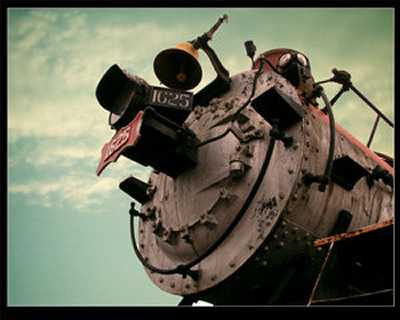 |
| Photo
by Justin Parson, courtesy of AMS Production Group |
III
I
moved even farther east for graduate
school, to the Carolinas. My beloved MP was nowhere in this area.
But other lines that I could explore were present. The Southern Railroad
(SOU) was the main carrier though the college town. It skirted the
populated area, so I didn't pay much attention to it. A short line,
the Carolina and Northwest (C&NW), ran through the backwoods and foothills
of the Blue Ridge Mountains, crossing a major lake, connecting with
the Southern right before that line entered Georgia, and extending
another seven miles to the little mountain town of Walhalla, where
it came to a drop dead halt. This seven-mile extension was apparently
rarely used; I never saw any rolling stock on it. The C&NW scheduled
only one train a day, so I always made a special effort to see it.
Frequently, I was not very successful, but when it did appear it was
usually a short make-up, sometimes sans caboose.
During the Civil War, near Walhalla, the Confederates began construction
of a railroad through the Blue Ridge range. One granite giant required
a tunnel, and about a mile of it was actually hollowed out. Whether
the money ran out, or the war's end made the line unnecessary, I don't
know, but construction was stopped and the project abandoned. The
partial tunnel was afterwards used for the storage of cheese. By the
time I lived in the area tourists had discovered the site and would
walk into the tunnel to its end. I did this several times and let
my imagination run wild.
Another little town about forty miles northeast of the college was
the terminus point for a short line, the Pickens Railroad (PIC). It
was only eight miles long and connected with the Southern at Easley,
South Carolina. The line was curvy and traveled though some heavily
wooded land. What was really attractive about the Pickens was all
the railroad equipment stored at the terminus: old passenger cars,
several cabooses, some steam engines, and tons of boxcars. Apparently,
the whole reason for the line's existence was to serve a paper mill.
On a spring Sunday in the late 1960s my office mate, Amos T., and
I walked the entire line to Easley and back again. Both of us were
exhausted at the end, but we saw some scenery that most people would
die for: deep dark woods, flowing streams, wildflowers, and unfamiliar
bird sounds. We never encountered a train; they didn't run on Sunday.
|
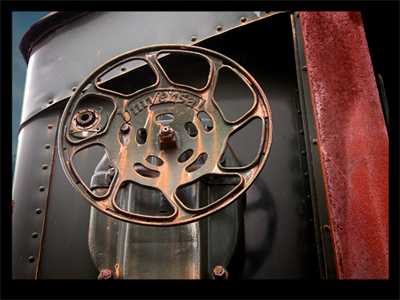 |
| Photo
by Justin Parson, courtesy of AMS Production Group |
IV
After
graduate school I moved back west, returning to Louisiana, where I
lived for about three years. My new hometown was 100 miles from the
place I had grown up. The MP line did come through the city, and seeing
those blue engines reminded me even more that my life swirls around
this tangible connection to my past.
But a new railroad caught my attention: the Arkansas and Louisiana
Missouri (A&LM). It was affectionately known as the "Gator Line" because
of the swampy terrain, full of reptilian creatures, that it traversed
for most of its route. An observer would get the impression that the
bed was one long trestle since so many of them were required to cross
the lowlands. Alligators and snakes would gather to sun themselves
around bridge pilings. If a train ever broke down along the way, repair
crews hesitated to go into the swamps to get it rolling again. The
tracks ran right in front of my apartment, so I frequently saw trains
on their way to Arkansas. I eventually had to say goodbye to this
picturesque line, though.
The move farther west to El
Paso placed me in an environment that required a major attitude
adjustment; in short, West
Texas was a cultural shock. A person from Louisiana and points
east would be accustomed to rain, green grass, trees, and noticeable
changes in the weather. West
Texas is barren, arid, and fairly meteorological stable. Much
of my time was spent attempting to overcome the negative thoughts
I had about the area and trying to regulate my life. My interest in
railroads waned somewhat.
The MP and Southern Pacific merged about 100 miles east of El
Paso and entered the city as a single line. The MP actually used
El Paso as
a western terminal point while the SP went on to California. Another
branch of the SP radiated out from El
Paso in a northeasterly direction toward the Texas
Panhandle and points in Kansas. This was the line I was most familiar
with because it paralleled the highway from El
Paso to Alamogordo, New Mexico. I traveled this road many times
either to the mountains or to White Sands National Park and was able
to observe long SP freight trains in and out of El
Paso. The Santa Fe (AT&SF) also entered El
Paso from Albuquerque and beyond. Trains tended to run on this
line at night, so I didn't get to see many of them. All the railroads
shared one station: Union
Station in downtown El
Paso. Out West I wasn't much of a steel rail explorer. I spent
too much time inside away from the heat and blowing wind. The MP heading
back toward Louisiana made me want to go home; the connection to my
past became more explicit. I often thought about hopping a freight
train and leaving, but marital obligations kept me fixed. |
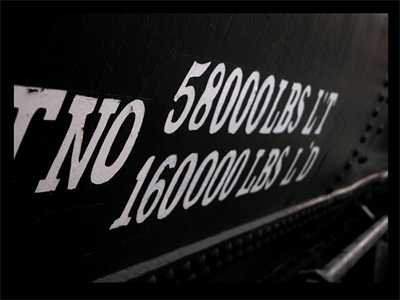 |
| Photo
by Justin Parson, courtesy of AMS Production Group |
V
The
obligations finally dissolved and I made my way back east but not
to Louisiana. Instead, I settled in the Dallas-Ft.
Worth area. By this time the Missouri Pacific had been absorbed
into the Union Pacific (UP) system. The engines were mostly a golden-yellow
with red lettering. Cabooses had been replaced by automatic signal
devices on the last car in line, thus eliminating the need for freight
train conductors. My first apartment was located about ten miles north
of the UP. Once an acquaintance of mine told me about a great steak
house I needed to check out, so one dark night I traveled the ten
miles south into unfamiliar territory and found the restaurant. It
was almost pitch black outside and I did not pay much attention to
my surroundings. I went inside, was seated and given water and utensils.
As I waited for my food, I noticed that my knife and fork were rattling,
the water in the glass was agitated, and the other patrons were looking
up from their prandial activities. Then I heard a rumbling noise and
the whole building started shaking. The movie Earthquake had been
released no more than a year previous to this time. I had seen it
in a theater which had been equipped with the special effects to make
the audience think that an earthquake was actually occurring even
as the movie was being shown. It was an impressive experience. My
first thought in the restaurant was: EARTHQUAKE! The truth was more
prosaic. The building was situated right next to the UP's main line
from California to New Orleans. A passing train caused the havoc in
my heart as I sat at my table. I obviously had not noticed the tracks
when I found the steak house. It's funny now, but I was genuinely
frightened at the time.
During the second installment of my singlehood, I managed to take
two train trips on AMTRAK. For the first one, the train left the Ft.
Worth station in the morning on a Friday and traveled down through
Texas to Laredo
on the banks of the Rio Grande across from Mexico.
This was in January, and I did not realize that the weather conditions
that far south could be so harsh. I took no warm clothing with me
and so was forced, due to financial constraints, to spend most of
my time in what would have been referred to during the Great Depression
years as a fleabag hotel. The place was a real dump, but at least
it was cheap and offered some shelter from the cold wind. AMTRAK ran
to Laredo
only every other day, so I could not come back until Sunday. Saturday
was a very long day. I did, however, enjoy the actual time I spent
on the train. The second journey was to Little Rock. The train left
Ft. Worth late in
the afternoon. It was almost dark by the time we were on the far side
of Dallas. The tracks paralleled
Interstate 20, and I noticed the train was out running all the cars
on the freeway. After that, darkness fell, and the rest of the trip
was blanked out, but the return one allowed me to see some nice scenery
in southern Arkansas and East
Texas.
A new marital situation allowed me to move closer to the UP, this
time about four miles south of the main line. I did not see many trains
everyday, but I could hear their whistles at night, a sound associated
with memories. I recalled all my years of never being too far away
from the railroad tracks. My life has been spent in a fairly concentrated
area. The T&P/MP/UP has run like a major artery through here. It has
appeared in both reality and in my dreams many times. My mind naturally
sees this phenomenon as symbolic. It points to my perpetual odyssey
over the land seeking something intangible; it is a reminder of possibilities
and lost opportunities, progress and regress, death and rebirth, an
escape route from the mundane, a chance to move to another place or
another job where success is more probable. The reach has always exceeded
the grasp. The UP is a silent witness to all my longings, a friend
that has shared my disappointments, my small triumphs and occasional
tragedies. The steel rail is a metaphorical umbilical cord that attaches
me to my beginnings.
When they were both in their eighties, my parents moved to the small
East Texas town of Gladewater,
also located on the UP California to New Orleans main line and in
a heavily wooded area of Texas. The scenery this route passes through
is almost indescribably beautiful: large pine trees, shocking violet
wisteria, and several rivers and streams. The tracks cut downtown
Gladewater in half.
When I was a kid, a movie theater stood on each side of the rails.
The one on the north side is long gone, but the southern one, the
old Cozy Theater, has become a local opry house. The place is popping
on Saturday nights, but whenever a freight train comes rolling down
the line - and they are quite frequent - the country music blaring
into the Texas night is drowned out by the roar of the engines. My
parents lived about five miles north of the UP, but little prevented
the sound of whistles floating through the night to reach my ears
whenever I visited them. |
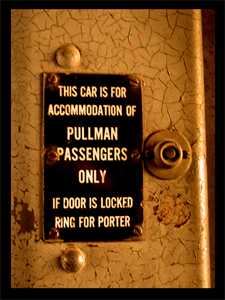 |
| Photo
by Justin Parson, courtesy of AMS Production Group |
| Photo
by Justin Parson, courtesy of AMS Production Group |
VI
For
the last six years I have been teaching at a small junior college
about 100 miles west of Ft.
Worth. I don't drive this distance everyday, but instead rent
an efficiency apartment to stay in during the week. The UP main line
runs right in front of the campus. I must see twenty-five trains per
day on this route. I find myself looking out the windows instead of
concentrating on my classes. At night I can hear the trains, about
two miles north of my apartment, rumbling through town.
Anticipating all the daily trains provides some relief. From the campus
I can see switching activities and observe those golden engines carry
large loads up an incline. The college town has an old, stately train
station still standing, half of which serves as a place for equipment
storage for the railroad work crews. The other half is now a museum
containing many artifacts and historical documents from the time the
town was a mecca for the oil boom around the turn of the twentieth
century. Since I am somewhat a history buff, I have made more than
one excursion to this museum. By consulting old newspapers, local
histories, and railroad maps, I discovered that a second line once
ran through the town. For the first two years of my employment, one
of my hobbies, one that has provided me many hours of both distraction
and pleasure, was to trace any remains of the abandoned railroad.
The Wichita Falls and Southern (WF&S), incorporated in 1907, ran south
from Wichita
Falls, Texas, to Jimkurn,
where it met the Wichita
Falls, Ranger and Ft. Worth (WFR&FW), which extended from Dublin
north through Breckenridge
and to Jimkurn. In 1927
the WF&S assumed control of the other line and the entire system became
the 169-mile long WF&S. The major profit-making commodities that kept
the railroad going for forty-seven years were oil and grain products.
Passenger service, using standard travel cars, was offered into the
1940s, but over time patrons were confined to riding in modified cabooses.
Reports of this experience are not very flattering. Business had declined
on the WF&S by the early 1950s, and in 1954 the company was given
permission from the ICC to fold the line except for the part between
Graham, Texas, and Breckenridge.
This section was taken over by the Rock Island and finally abandoned
completely in 1969 when the CRI&P itself left the area. Of course,
when a railroad dissolves as a business the rails are removed and
usually sold for scrap; trestles are often dismantled, but the beds
are left intact. Over the years nature does its work, but some traces
of a former line always remain. Any persistent railroad aficionado
will always find hidden treasures if he puts his mind to it.
And I was determined. First of all, I found that two former stations
from the WF&S halcyon days are still standing, one at the terminal
point in Dublin,
the other in Breckenridge.
The former is used as an office building, the latter as an antique
shop. I started tracing the line from Wichita
Falls south. From Archer
City, locale of Larry McMurtry's The Last Picture Show, south
to Olney, the trackbed
of the WF&S is clearly visible in many places, but there are some
gaps where farmers have rendered the ground level for planting crops.
The line disappears between Olney
and Newcastle although
one can see where the trains passed through downtown Newcastle.
Next, is a train station that was jointly shared with the Rock Island
at Graham, a building
in sad repair, one that should be preserved, if for no other reason,
than for its architectural marvel. Farther down the road at South
Bend a magnificent concrete trestle still stands. The railroad
paralleled the Brazos River to Eliasville.
Several old bridge spans are in place even today. It is difficult
to trace the line from Eliasville
to Breckenridge
because it leaves the accessible highway and makes its journey through
mesquite trees and scrub brushes that dot this part of the world.
South of Breckenridge
the old line headed toward Ranger,
once a sprawling place full of oil derricks and wildcatters but now
a dilapidated shell of its former self. Signs of the location where
the WF&S crossed the UP main line can still be seen although the trackbed
is full of cacti and small plants. When Interstate 20 was built through
the area, much of the bed was plowed under, but if one looks closely
a little section of the old WF&S, paralleling a small creek, comes
into view. From this point south to where it connected with both the
Santa Fe and Texas Central (TCRR) in Dublin
almost all remnants of the line disappear except for the old station
at the end. Additionally, there is one place just south of Ranger
where a trainophile, if he looks closely, can notice the old trackbed
crossing a farm to market road: this, the terminal station, and nothing
more. |
The WF&S was
a witness to much of the history of west-central Texas. But nature
is reclaiming her own, and in another decade few signs of the old
line will remain. I spent the better part of four semesters trying
to follow the route, driving my vehicle on barely accessible roads
into tangled forests, sparsely inhabited farm land, and through hamlets
and small towns just for a glimpse of what was once, for a thriving
geographical area, a lifeline to the markets. This section of the
country is economically strapped now, and the old iron trail is gone,
but if it were a sentient creature, it would certainly be amazed to
learn that it gave an eager railroad buff hours of pleasure fifty
years after its demise.
Serendipitously, not far away from the school campus, another old
railroad once plied its way north from Cisco,
Texas, to Throckmorton.
The Cisco and Northeastern (C&NE) ran from a connection with the T&P
at Cisco in a northeasterly
direction to Breckenridge,
where it had a station and freight house across Gonzalez Creek from
the WF&S station. Then it curved in a northwestern path and went through
the village of Crystal Falls, the town of Woodson,
ending its trek at Throckmorton.
The length of the entire line was sixty-five miles, and it operated
successfully from 1918 to 1942. The rails were removed in 1943 to
be used to satisfy the steel demand during World War II. When I first
explored this part of Texas, I quickly found that the embankment for
the C&NE is clearly visible from Cisco
to about ten miles north. Many of the trestle supports were concrete
and these are still in place sixty years after abandonment. In Breckenridge
there are signs where the old station once stood, off Walker Street
on the eastern edge of downtown. The next evidence for the line's
existence are old stone pilings for a bridge span still standing in
the middle of the Brazos River just south of Crystal Falls. North
of this area is unexplored territory for me, a future project to look
forward to.
Another shortline once rolled through this area from 1918 to 1944:
the Eastland, Wichita Falls and Gulf Railroad (EWF&G). It branched
off the WF&S just southeast of Breckenridge
at a junction called Breckwalker, traveled south through Wayland and
Eastland, Texas, and
cut southwest to connect with the Missouri, Kansas and Texas (MK&T),
now the TCRR, at the now-deserted village of Mangum. The original
plans called for the tracks to extend from May,
Texas, to Newcastle, a distance of ninety-six miles, but only
twenty-eight miles were ever completed. The railbed is still visible
just north of Wayland and around Ringling Lake in Eastland.
In fact, at the latter location the locomotives once stopped to take
water from the lake. The line paralleled the Leon River south of Eastland,
and an acute observer will notice where it crossed Main Street on
the west side of the river highway bridge. The embankment is also
visible where the line crossed Highway 6 south of Eastland.
And then there is the ghost town of Thurber,
once a thriving mining locale with a population around 10,000, located
on a six-mile spur of the T&P that connected with the main line at
Mingus, Texas. Thurber
was the principal coalmining town in Texas from 1886 to the early
1930s. It supported stores, saloons, schools, churches, a large hotel
and an opera house. A brick factory was also established in the area,
one that supplied so many bricks that many towns circling Thurber
were able to pave city streets with them. Today, remains of the spur
rail line are quite visible as one passes through Thurber
on Interstate 20. The freeway actually cuts one branch in two, and
an observer can see how overpass trestles were constructed using brick
supports. Another branch of the spur veers off to the west and parallels
the interstate for several miles before abruptly ending at what was
probably a slush dump. Some restoration projects are in the works
at Thurber;
one can only hope the spur line will be on the receiving end.
|
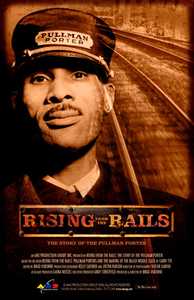 |
| Photo
by Justin Parson, courtesy of AMS Production Group |
| Photo
by Justin Parson, courtesy of AMS Production Group |
VII
I
like railroads. I like tracks. I like trains. I like watching trains.
I think I've made this profusely clear. Emily Dickinson can speak
for me in this regard: |
I like to see
it lap the Miles -
And lick the Valleys up -
Complaining all the while
In horrid - hooting stanza -
Then - prompter than a Star
Stop - docile and omnipotent
At its own stable door |
In particular
my beloved T7P/MP/UP has shared itself with me in an almost symbiotic
relationship. It is the steel artery of my life. I will probably always
live near it. Trains partially fulfill a predilection in me for wanderlust
and nostalgia. The cacophony of sounds, the sight of the rails, just
the movement of these mammoths take me back to the past, remind me
that I have wasted opportunity after opportunity, failed to go through
open doors, shut other doors intentionally, and burned a few bridges
along the way. In short, I have been a flaneur. For my approaching
dotage Melancholy has started adoption procedures to nurture me in
my remaining years. Trains remind me that I have not paid much attention
to forward progress. I want to apologize for this. I feel remorse
for mistakes I've made, wrong turns I've taken, and attitudes that
I've inculcated in myself and in others. To whom do I owe this apology?
God? My wife? Myself? To whomever: I'm truly sorry. And, I need trains
to enforce my regrets, to be constant reminders for me to strive for
improvement, to never stand still.
Trains, with their haunting sounds, will continue to move. This is
good. From my classroom window I see one approaching now. Think I
will dismiss the little cherubs and go take a closer look. |
|
|
